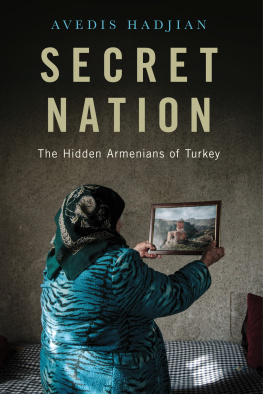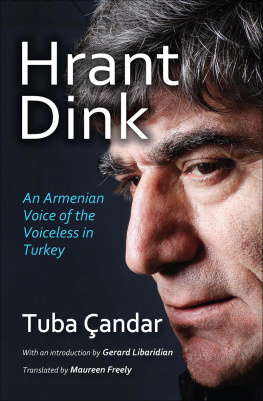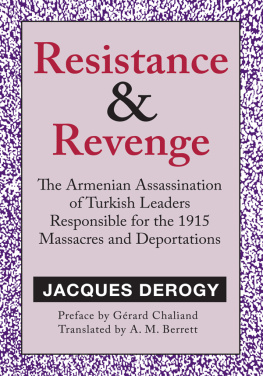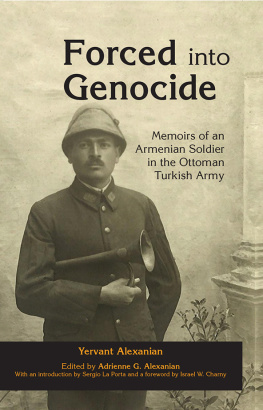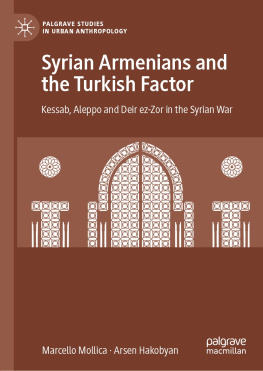Warrant for
GENOCIDE
First published 1999 by Transaction Publishers
Published 2017 by Routledge
2 Park Square, Milton Park, Abingdon, Oxon OX14 4RN
711 Third Avenue, New York, NY 10017, USA
Routledge is an imprint of the Taylor & Francis Group, an informa business
Copyright 1999 Taylor & Francis
All rights reserved. No part of this book may be reprinted or reproduced or utilised in any form or by any electronic, mechanical, or other means, now known or hereafter invented, including photocopying and recording, or in any information storage or retrieval system, without permission in writing from the publishers.
Notice:
Product or corporate names may be trademarks or registered trademarks, and are used only for identification and explanation without intent to infringe.
Library of Congress Catalog Number: 98-46214
Library of Congress Cataloging-in-Publication Data
Dadrian, Vahakn N.
Warrant for genocide: key elements of Turko-Armenian conflict / Vahakn N. Dadrian.
p. cm.
Includes bibliographical references (p. ) and index.
ISBN 0-7658-0559-6 (alk. paper)
1. Armenian massacres, 1915-1923. I. Title.
DSI95.5.D337 1998
956.6'2015dc21
98-46214
CIP
ISBN 13: 978-0-7658-0559-1 (pbk)
Contents
Appendix: The Questionable Features of the Ottoman Calculus of the Demography of the Armenians
As you know the [Armenian] deportations were an event that triggered a worldwide outcry and caused us to be regarded as murderers. Before embarking upon it we knew that the Christian world would not indulge us and would direct its full wrath and deep-seated enmity against us on account of it. Why have we then [opted for] appending to ourselves the label of murderers (Neden katillik unvanini nefsimize izafe ettik)! Why have we involved ourselves in such a grave and difficult conflict? We acted thusly simply to ensure the future of our fatherland that we consider to be dearer and more sacred to us than our own lives. From a speech delivered by Deputy Hasan Fehmi (Ata) during the 17 October 1920 secret sitting of the fledgling Kemalist Parliament in Ankara, presided over by Mustafa Kemal (Atatiirk) himself. Subsequently Ataturk appointed him finance minister, a position in which Hasan Fehmi faithfully served in the 24 April 19222 January 1925 period.
Source: T.B.M.M. Gizli Celse Zabitlari (The proceedings of the secret sessions of the Grand National Assembly of Turkey), vol. 1 (Ankara, 1985), p. 177. For an examination of Fehmis unabashed defense of the economic objectives of the governmental scheme of the wartime Armenian genocide and his parallel postwar economic policies which as finance minister he instituted against the scant survivors of that genocide see Vahakn N. Dadrain Genocide as a Problem of National and International Law: The World War I Armenian Case and Its Contemporary Legal Ramifications, Yale Journal of International Law, vol. 14, no. 2 (summer 1989), pp. 2701.
From the Interior Ministry to the Diyarbekir Province:
It has been reported to us that the Armenians of the province of Diyarbekir, along with other Christians, are being massacred, and that some 700 Armenians and other Christians, were recently slaughtered in Mardin like sheep after having been removed from the city through nightly operations. The number of people thus far slain through such massacres is estimated to be 2,000. It is feared that unless these acts are stopped definitely and swiftly the Muslim population of the region too may proceed to massacre the general Christian population. The political and disciplinary measures (tedbiri inzibatiye ve siyasiye) adopted against the Armenians are absolutely not to be extended to other Christians as such acts are likely to create a very bad impression upon public opinion [italics added]. You are ordered to put an immediate end to these acts lest they threaten the lives of the other Christians indiscriminately (alel-itlk Hiristiyanlarin hayatini tehdid edecek). Keep us informed of the true state of the matter.
[Interior] Minister [Talt], 29 June 1915
Source: T.C. Babakanlik Devlet Genel Mdrl. Osmanli Arivi Daire Bakanlii (General Directorate of the State Archives. Prime Ministry of the Turkish Republic), Osmanli Belgelerinde Ermeniler, 19151920 (The Armenians in Ottoman Documents 19151920), (Ankara, 1994), doc. no. 71, p. 69.
Abbreviations
AA = Auswrtiges Amt. German Foreign Office Archives. Political Department 1A (Berlin: presently Bonn)
BA/MA = Bundesarchiv/Militrarchiv. The military archives of the German Federal Republic, Freiburg im Breisgau
Cong. Ree. = Congressional Record
DAA = Diplomatic Archives of Austria, nineteenth century
DAF = Diplomatic Archives of France, nineteenth century
DAG = Diplomatic Archives of Germany, nineteenth century
Doc. = Document
DZA = Deutsches Zentralarchiv: The archives of the former German Democratic Republic (East Germany), Potsdam
FO = British Foreign Office Archives
K = Botschaft Konstantinopel (German Consular Files)
N.S. = Nouvelle Srie. French Foreign Ministry Archives (AMAE), Departments Turquie (Armnie) and Jeunes Turcs. Guerre: volumes 8879, covering events relating to Armenia from August 1914 to May 1918 under the heading Turquie.
RG= Record Group, U.S. National archives, Papers Relating to the Foreign Relations of the U.S. 1915 Supplement. World War I
TV. = Takvimi Vekyi. Official gazette of the Ottoman government, whose special supplements covering the proceedings of the Extraordinary Turkish Military Tribunal served as a judicial gazette.
A note on the use of dual-track dates:
Because of the prevalence in the respective periods of the twentieth century of the thirteen-day differential (twelve-day for the nineteenth century) between the Ottoman calendar, otherwise called rumi, Julian, or old style (o.s.), and the European-Western calendar, otherwise called miladi, Gregorian, or new style (n.s.), both variants have been adduced in connection with the narration of certain specific events for which purpose parentheses have been used.
Introduction
The Proceedings of the 191920 Turkish Courts Martial were replete with indications that the World War I destruction of the Armenian people in the Ottoman Empire was neither an accident nor an aberration. The essence of a plan for large-scale deportations and massacres, developed by the leaders of the reigning Young Turk Ittihadist regime, was evident in the ensemble of documents marshaled by the Military Tribunal. The Tribunals Key Indictment and Key Verdict served to highlight the components of that lethal plan; as part of the legal evidence both documents were published in the Ottoman governments gazette, the Takvimi Vekyi, numbers 3540 and 3604, respectively. It needs to be emphasized here that all the verdicts of this Military Tribunal were, just like in the case of the Nuremberg Tribunal, nearly entirely predicated upon official Turkish documents. The authenticity of each one of these was certified by competent Interior Ministry officials with the notation it conforms to the original. This fact is of paramount significance for the proper assessment of the value of the findings of this Court. One may discern four essential features in the conception, design, and implementation of that plan: (1) a xenophobic nationalism, nurtured by atavistic impulses of Turkism aiming at the elimination of the Armenians as a non-Turkic and discordant minority; (2) the resort to violence through the use of arms to achieve that end; (3) reliance on the potential of Islam to incite the masses against the targeted Christian Armenians, (despite the irreligious stance of most of the Ittihadist leaders); (4) the maintenance of the utmost secrecy of the scheme, to be safeguarded by camouflage and deflection. In other words, the leadership of Ittihad is revealed here as having engaged in careful deliberations leading to the adoption of a radical policy for the resolution of a historically lingering nationality conflict.


